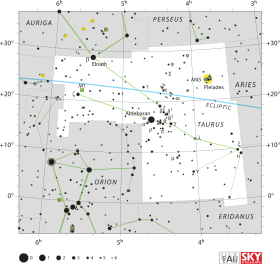Mu Tauri
| Observation data Epoch J2000 Equinox J2000 | |
|---|---|
| Constellation | Taurus |
| Right ascension | 04h 15m 32.05687s[1] |
| Declination | 08° 53′ 32.4916″[1] |
| Apparent magnitude (V) | 4.27[2] |
| Characteristics | |
| Spectral type | B3IV[3] |
| U−B color index | −0.51[4] |
| B−V color index | −0.05[4] |
| Astrometry | |
| Radial velocity (Rv) | +16.3±0.6[5] km/s |
| Proper motion ( | RA: +20.881[1] mas/yr Dec.: −22.789[1] mas/yr |
| Parallax ( | 6.6651 ± 0.3319 mas[1] |
| Distance | 490 ± 20 ly (150 ± 7 pc) |
| Absolute magnitude (MV) | −1.45[2] |
| Details | |
| Mass | 6.7[6] M☉ |
| Luminosity | 462[2] L☉ |
| Surface gravity (log g) | 3.75[7] cgs |
| Temperature | 16,980[7] K |
| Metallicity [Fe/H] | −0.16[2] dex |
| Rotational velocity (v sin i) | 89[8] km/s |
| Age | 252[9] Myr |
| Other designations | |
| Database references | |
| SIMBAD | data |
This object has a stellar classification of B3IV,[3] matching a B-type subgiant star. In the past this star was thought to have a variable radial velocity, but is now considered constant.[12] It is 252[9] million years old and is spinning with a projected rotational velocity of 89 km/s.[8] The star has 6.7[6] times the mass of the Sun and is radiating 462[2] times the Sun's luminosity from its photosphere at an effective temperature of 16,980 K.[7] It is emitting an infrared excess at a wavelength of 18
References
[edit]- ^ a b c d e f Brown, A. G. A.; et al. (Gaia collaboration) (August 2018). "Gaia Data Release 2: Summary of the contents and survey properties". Astronomy & Astrophysics. 616. A1. arXiv:1804.09365. Bibcode:2018A&A...616A...1G. doi:10.1051/0004-6361/201833051. Gaia DR2 record for this source at VizieR.
- ^ a b c d e f Anderson, E.; Francis, Ch. (2012). "XHIP: An extended hipparcos compilation". Astronomy Letters. 38 (5): 331. arXiv:1108.4971. Bibcode:2012AstL...38..331A. doi:10.1134/S1063773712050015. S2CID 119257644. Vizier catalog entry
- ^ a b Lesh, Janet Rountree (December 1968), "The Kinematics of the Gould Belt: an Expanding Group?", Astrophysical Journal Supplement, 17: 371, Bibcode:1968ApJS...17..371L, doi:10.1086/190179
- ^ a b Mallama, A. (2014). "Sloan Magnitudes for the Brightest Stars". The Journal of the American Association of Variable Star Observers. 42 (2): 443. Bibcode:2014JAVSO..42..443M.Vizier catalog entry
- ^ a b Gontcharov, G. A. (2006). "Pulkovo Compilation of Radial Velocities for 35 495 Hipparcos stars in a common system". Astronomy Letters. 32 (11): 759–771. arXiv:1606.08053. Bibcode:2006AstL...32..759G. doi:10.1134/S1063773706110065. S2CID 119231169.
- ^ a b Tetzlaff, N.; et al. (2011). "A catalogue of young runaway Hipparcos stars within 3 kpc from the Sun". Monthly Notices of the Royal Astronomical Society. 410 (1): 190–200. arXiv:1007.4883. Bibcode:2011MNRAS.410..190T. doi:10.1111/j.1365-2966.2010.17434.x. S2CID 118629873. Vizier catalog entry
- ^ a b c Soubiran, Caroline; et al. (2016). "The PASTEL catalogue: 2016 version". Astronomy & Astrophysics. 591: A118. arXiv:1605.07384. Bibcode:2016A&A...591A.118S. doi:10.1051/0004-6361/201628497. S2CID 119258214.
- ^ a b Hoffleit, D.; Warren, W. H. (1995). "Bright Star Catalogue". VizieR On-line Data Catalog: V/50. Originally Published in: 1964BS....C......0H. 5050 (5th Revised ed.). Bibcode:1995yCat.5050....0H.
- ^ a b Gontcharov, G. A. (November 2012), "Spatial distribution and kinematics of OB stars", Astronomy Letters, 38 (11): 694–706, arXiv:1606.09028, Bibcode:2012AstL...38..694G, doi:10.1134/S1063773712110035, S2CID 119108982
- ^ "mu Tau". SIMBAD. Centre de données astronomiques de Strasbourg.
- ^ Eggleton, P. P.; Tokovinin, A. A. (September 2008). "A catalogue of multiplicity among bright stellar systems". Monthly Notices of the Royal Astronomical Society. 389 (2): 869–879. arXiv:0806.2878. Bibcode:2008MNRAS.389..869E. doi:10.1111/j.1365-2966.2008.13596.x. S2CID 14878976.
- ^ Percy, J. R.; Lane, M. C. (May 1977). "Search for Beta Cephei stars. I - Photometric and spectroscopic studies of northern B-type stars". Astronomical Journal. 82: 353–359. Bibcode:1977AJ.....82..353P. doi:10.1086/112057.
- ^ Ishihara, Daisuke; et al. (May 2017). "Faint warm debris disks around nearby bright stars explored by AKARI and IRSF". Astronomy & Astrophysics. 601: 18. arXiv:1608.04480. Bibcode:2017A&A...601A..72I. doi:10.1051/0004-6361/201526215. S2CID 55234482. A72.

